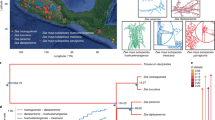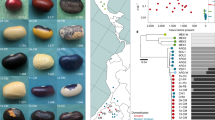Abstract
The domestication of all major crop plants occurred during a brief period in human history about 10,000 years ago1. During this time, ancient agriculturalists selected seed of preferred forms and culled out seed of undesirable types to produce each subsequent generation. Consequently, favoured alleles at genes controlling traits of interest increased in frequency, ultimately reaching fixation. When selection is strong, domestication has the potential to drastically reduce genetic diversity in a crop. To understand the impact of selection during maize domestication, we examined nucleotide polymorphism in teosinte branched1, a gene involved in maize evolution2. Here we show that the effects of selection were limited to the gene's regulatory region and cannot be detected in the protein-coding region. Although selection was apparently strong, high rates of recombination and a prolonged domestication period probably limited its effects. Our results help to explain why maize is such a variable crop. They also suggest that maize domestication required hundreds of years, and confirm previous evidence that maize was domesticated from Balsas teosinte of southwestern Mexico.
This is a preview of subscription content, access via your institution
Access options
Subscribe to this journal
Receive 51 print issues and online access
$199.00 per year
only $3.90 per issue
Buy this article
- Purchase on Springer Link
- Instant access to full article PDF
Prices may be subject to local taxes which are calculated during checkout


Similar content being viewed by others
References
Harlan, J. Crops and Man (Am. Soc. Agron., Madison, WI, (1992).
Doebley, J., Stec, A. & Gustus, C. Teosinte branched1 and the origin of maize: evidence for epistasis and the evolution of dominance. Genetics 141, 333–346 (1995).
Beadle, G. Teosinte and the origin of maize. J. Hered. 30, 245–247 (1939).
Galinat, W. The origin of maize as shown by key morphological traits of its ancestor, teosinte. Maydica 28, 121– 138 (1983).
Iltis, H. From teosinte to maize: the catastrophic sexual transmutation. Science 222, 886–894 ( 1983).
Smith, B. The Emergence of Agriculture (Freeman, New York, (1995 ).
Doebley, J., Stec, A. & Hubbard, L. The evolution of apical dominance in maize. Nature 386, 485–488 ( 1997).
Watterson, G. On the number of segregating sites in genetical models without recombination. Theor. Popul. Biol. 7, 188– 193 (1975).
Eyre-Walker, A., Gaut, R., Hilton, H., Feldman, D. & Gaut, B. Investigation of the bottleneck leading to the domestication of maize. Proc. Natl Acad. Sci. USA 95, 4441–4446 (1998).
Buckler, E. & Holtsford, T. Zea systematics: ribosomal ITS evidence. Mol. Biol. Evol. 13, 612– 622 (1996).
Goloubinoff, P., Paabo, S. & Wilson, A. Evolution of maize inferred from sequence diversity of an Adh2 gene segment from archaeological specimens. Proc. Natl Acad. Sci. USA 90, 1997–2001 (1993).
Hanson, M. et al. Evolution of anthocyanin biosynthesis in maize kernels: the role of regulatory and enzymatic loci. Genetics 143 , 1395–1407 (1996).
Hilton, H. & Gaut, B. Speciation and domestication in maize and its wild relatives. Evidence from the globulin-1 gene. Genetics 150, 863–872 ( 1998).
Doebley, J., Goodman, M. & Stuber, C. Isoenzymatic variation in Zea (Gramineae). Syst. Bot. 9, 203–218 ( 1984).
Hudson, R., Kreitman, M. & Aguade, M. Atest of neutral molecular evolution based on nucleotide data. Genetics 116, 153– 159 (1987).
Stam, L. F. & Laurie, C. C. Molecular dissection of a major gene effect on a quantitative trait: the level of alcohol dehydrogenase expression in Drosophila melanogaster. Genetics 144, 1559–1564 (1996).
Kaplan, N., Hudson, R. & Langley, C. The “hitchhiking effect” revisited. Genetics 123, 887–899 ( 1989).
Okagaki, R. & Weil, C. Analysis of recombination sites within the maize waxy locus. Genetics 147, 815–821 (1997).
Patterson, G., Kubo, K., Shroyer, T. & Chandler, V. Sequences required for paramutation of the maize b gene map to a region containing the promoter and upstream sequences. Genetics 140, 1389–1406 (1995).
Dooner, H. & Martinez-Ferez, I. Recombination occurs uniformly within the bronze gene, a meiotic recombination hotspot in the maize genome. Plant Cell 9, 1633– 1646 (1997).
Xu, X., Hsia, A., Zhang, L., Nikolau, B. & Schnable, P. Meiotic recombination break points resolve at high rates at the 5′ end of a maize coding sequence. Plant Cell 7, 2151–2161 (1995).
Kimura, M. & Ohta, T. The average number of generation until fixation of a mutant gene in a finite population. Genetics 61, 763–771 (1969).
Hudson, R. Properties of a neutral allele model with intragenic recombination. Theor. Popul. Biol. 23, 183–201 (1983).
Bevan, M. et al. Analysis of 1.9 Mb of contiguous sequence from chromosome 4 of Arabidopsis thaliana. Nature 391, 485–488 (1998).
Doebley, J. & Stec, A. The structure of teosinte branched1 : a progress report. Maize Genet. Coop. News1. 73(1998).
Acknowledgements
We thank E. Buckler, B. Gaut and J. Wendel for comments. This research was supported by the NSF and the Plant Molecular Genetics Institute of the University of Minnesota.
Author information
Authors and Affiliations
Corresponding author
Rights and permissions
About this article
Cite this article
Wang, RL., Stec, A., Hey, J. et al. The limits of selection during maize domestication. Nature 398, 236–239 (1999). https://doi.org/10.1038/18435
Received:
Accepted:
Issue Date:
DOI: https://doi.org/10.1038/18435
This article is cited by
-
Laboratory and field evaluation of maize resistance to the two-spotted spider mite, Tetranychus urticae
Journal of Pest Science (2023)
-
Dominant complementation of biological pathways in maize hybrid lines is associated with heterosis
Planta (2022)
-
Fine mapping and candidate gene analysis of the up locus determining fruit orientation in pepper (Capsicum spp.)
Theoretical and Applied Genetics (2021)
-
Diversification of maize (Zea mays L.) through teosinte (Zea mays subsp. parviglumis Iltis & Doebley) allelic
Genetic Resources and Crop Evolution (2021)
-
Comparative transcriptome analyses of fruit development among pears, peaches, and strawberries provide new insights into single sigmoid patterns
BMC Plant Biology (2020)
Comments
By submitting a comment you agree to abide by our Terms and Community Guidelines. If you find something abusive or that does not comply with our terms or guidelines please flag it as inappropriate.



